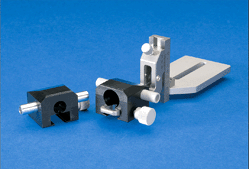Rodent Anesthesia Masks and Breathing Manifolds
- Choice of 2 Port, 4 Port or 6 Port Splitter Manifold w/ Tubing
- Each Port supports an RES500 Nosecone Circuits or Induction Chamber
- Each port can individually be opened or closed
- Nose Cone Circuits & Induction Chambers not included
- Can be used with F/AIR Canisters

Rodent Non-Rebreathing Circuit with Nose Cone
This acrylic manifold allows the position of the inside gas supply tube to be adjusted for any size rat or mouse, reducing dead-space and preventing CO2 build up. The nose gasket can be customized to fit any shape by cutting a hole in the diaphragm, and the evacuation end accepts both 19mm & 22mm hosing. Includes 10 replaceable diaphragms. ARES500 nosecone/mask measures 25mm diameter. An optional 38mm diameter mask is available for larger rodents.
| Model ARES500 | Rodent Non-Rebreathing Circuit with Nose Cone | $72.00 | |
| Model ARES505 | Waste Gas interface to connect RES500 to medical vacuum outlets. | $55.00 |
Multi Station Pressure-Equalized Manifolds

| Features:
|
|||||||||||||||||
|
|||||||||||||||||

Small Animal Anesthesia Masks
The pliable small, medium and large anesthesia masks are made from soft, pliable, transparent, vinyl plastic compound. Suitable for feline use as well as other small animals. The smaller sizes can be used with Guinea pigs and large rabbits. Small and medium masks have a 15mm standard male connection. The large feline anesthesia mask and rigid small canine mask (Not Pictured) have a standard 22mm female hose connection.
|
|||||||||||||||||||||||||
Click to view Related Items :

Gas Anesthesia Mask for Stereotaxic
Designed for mice or rats in a Stereotaxic Instrument. The Gas Adaptors for Stereotaxic instruments, enable gas anesthesia of rats or mice in a Lab Standardâ„¢ or other stereotaxic instrument, without exposing the researcher to the gas. The Gas Anesthesia mask is installed by removing the nose clamp from the standard rat adaptor, and sliding the adaptor over the incisor bar, with the cone opening toward the open “U”. The animal (rat or mouse) is installed by placing its teeth over the incisor bar, and sliding the adaptor forward until the cone is snug about the animal’s nose, thereby substituting for the nose clamp. The teeth and the cone provide a snug, stable hold. Anesthetic gas flows in the tubing connector, past the animal’s nose, and out the other side, where it may be routed to recycling, exhaust, or gas analysis instruments.
|
|||||||||

